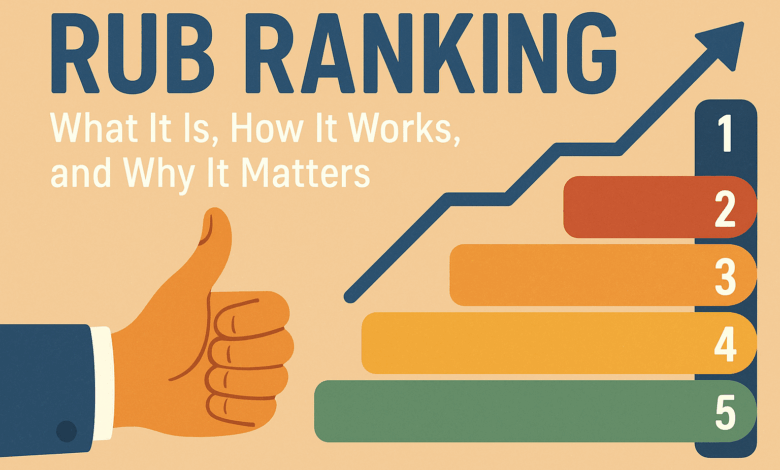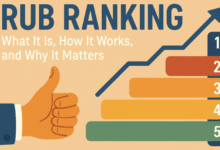Rub Ranking: A Casual Expert’s Guide to Understanding, Using, and Mastering It

When it comes to measuring performance, comparing options, or simply trying to figure out who (or what) comes out on top, the concept of rub ranking often enters the conversation. It sounds almost playful, but in reality, rub rank is a practical method used in different fields—from marketing and sports analysis to online reviews and even decision-making strategies.
So, let’s take a deep dive into rub ranking: what it really is, why it matters, how it’s applied, and what pitfalls to watch out for. I’ll break this down in plain, casual language, but with the detail and precision you’d expect from an expert who knows the ropes.
What Exactly is Rub Ranking?
At first glance, the phrase rub ranking might sound like something you’d hear in a cooking competition or a massage therapy contest. But step back, and you’ll realize it’s essentially about ordering, prioritizing, or scoring items based on specific rubrics or criteria.
Think of it this way: if you’ve got a list of candidates for a job, products on a store shelf, or even sports teams in a league, you need some way of ranking them. Rub rank is about applying consistent “rubrics”—standards or benchmarks—to measure performance and then arranging the results from top to bottom.
The beauty of rub ranking is that it doesn’t rely on gut feelings or favoritism alone. Instead, it uses structured metrics (like customer satisfaction scores, efficiency ratings, or test results) to create a hierarchy that’s easier to understand. Imagine shopping for a laptop. You don’t just grab the shiniest one; you look at processing speed, price, battery life, and brand trust. That’s rub ranking at work in your everyday life.
Another way to think about rub rank is as the middle ground between raw numbers and human judgment. It acknowledges the importance of quantifiable data but also leaves room for qualitative factors. That’s why it’s increasingly popular in industries that want both fairness and flexibility.
Why Rub Ranking Matters More Than You Think

Now, you might be wondering: “Okay, but why should I care about rub ranking?” The answer lies in how decisions are made—big or small. Without a ranking system, you’re essentially choosing blindfolded, relying on guesswork. With rub ranking, you have a structured way to compare apples to apples.
For businesses, rub ranking plays a vital role in competitive positioning. If you’re a company launching a new product, you need to know where you stand against rivals. By scoring features, pricing, and customer reviews, you can see if you’re near the top or if you’ve got some climbing to do.
On a personal level, rub ranking sneaks into your life more often than you realize. Consider universities and how they evaluate applicants. They don’t just toss your name in a hat. They rank you based on GPA, extracurriculars, essays, and test scores. That’s rub ranking making a real difference in people’s futures.
And here’s the kicker: rub ranking isn’t just about identifying winners and losers. It’s also about highlighting improvement areas. If you see you’re in the middle of the pack, you immediately know where to push harder. That’s a lot better than wandering aimlessly, hoping for results.
How Rub Ranking Works in Practice
Okay, enough theory—how does rub ranking actually work? Let’s break it down step by step, in the most practical sense possible.
Step 1: Define the Criteria (The Rubrics).
This is where everything starts. You can’t rank anything without first deciding what matters. In a sports setting, the rubric could be goals scored, assists, and win/loss record. In education, it could be exam scores, attendance, and participation. In business, maybe it’s sales, customer satisfaction, and innovation.
Step 2: Assign Weights to Each Criterion.
Not all factors matter equally. Let’s say you’re ranking cars. Fuel efficiency might matter more than color. In rub ranking, you give higher weight to what’s more important so that the results are balanced and meaningful.
Step 3: Collect the Data.
Here comes the legwork—gathering actual numbers or observations. Whether it’s statistics, survey results, or performance logs, you need solid inputs to generate reliable rankings.
Step 4: Calculate and Compare.
Now you put it all together. Score each item against your rubric, apply the weights, and then arrange them in order. Voilà—you’ve got yourself a rub rank list.
Step 5: Review and Adjust.
This step often gets skipped, but it’s critical. After generating rankings, you need to step back and ask, “Does this actually reflect reality?” Sometimes, the data misses nuances. That’s when expert judgment comes into play, fine-tuning the results.
Common Uses of Rub Ranking Across Fields
Rub ranking may sound like a niche idea, but trust me, it’s everywhere once you know where to look.
In Sports: Rankings decide everything from playoff seeds to MVP awards. A player’s rub rank might be based on points, rebounds, assists, or even advanced metrics like efficiency rating. Fans argue about it endlessly, but the underlying system is usually some form of rub ranking.
In Education: Teachers and institutions use rubrics to grade students. That’s the classic example of rub ranking. An essay isn’t just “good” or “bad”—it’s judged on grammar, originality, argument strength, and formatting.
In Business and Marketing: Companies use rub rank to evaluate strategies, product lines, or even employees. Imagine you’re deciding which marketing campaign to continue funding. Rub ranking helps you weigh ROI, audience reach, and engagement, and then decide which campaign deserves more attention.
In Everyday Life: Even casual decisions—like picking a restaurant, choosing a movie, or buying a phone—often involve informal rub ranking. You’re balancing price, quality, reviews, and personal preference.
Advantages and Limitations of Rub Ranking
Like any system, rub ranking has its strengths and weaknesses. Knowing them helps you use it wisely without falling into traps.
Advantages:
- Objectivity – By relying on predefined criteria, rub ranking reduces the risk of bias.
- Clarity – Rankings make complex comparisons digestible. Instead of drowning in data, you get a clear order.
- Decision Support – It helps in making rational, justifiable choices.
Limitations:
- Over-Simplification – Life is messy, and not everything can be boiled down to numbers. Rub ranking may ignore intangible factors like creativity or intuition.
- Criteria Bias – If the rubric itself is flawed, the whole ranking is skewed. Garbage in, garbage out.
- Static Nature – Rankings can quickly become outdated if not updated with fresh data.
At the end of the day, rub rank is powerful but not foolproof. Think of it like GPS navigation: it’ll usually get you close to where you need to be, but sometimes you’ll need to rely on your own sense of direction.
How to Master Rub Ranking for Smarter Decisions
Want to get better at rub ranking? Here are a few expert tips to keep in your back pocket:
- Be Honest About Priorities. Don’t pretend all criteria are equal. Decide what really matters before scoring.
- Mix Data with Judgment. Numbers give structure, but context gives meaning. Combine both for accuracy.
- Update Frequently. A ranking from last year won’t always hold true today. Refresh your rub ranking as circumstances change.
- Test Your System. Apply your rub rank in small scenarios first, see if it reflects reality, then expand it.
Mastering rub ranking isn’t about becoming a robot. It’s about finding a balance between structure and common sense, making your choices sharper and more defensible.
Final Thoughts on Rub Ranking
At its core, rub ranking is less about numbers and more about clarity. It gives us a framework to understand the messy world of options, comparisons, and decisions. From classrooms to boardrooms, and even in casual daily life, rub rank shows up everywhere as a quiet but powerful tool.
The next time you’re stuck deciding between two paths—or ten—you’ll probably find yourself doing some version of rub ranking without even realizing it. The difference now is that you’ll know exactly what you’re doing, why it matters, and how to do it better.
So whether you’re a student, a business professional, or just someone who likes organizing things, remember: rub rank isn’t just a method. It’s a mindset.




